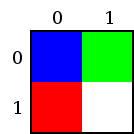February 27th, 2017 by Ryan Hamilton
qUnit has added a new HTML report to allow visually easily seeing the difference between expected kdb results and actual results. To generate a report you could call:
.qunit.generateReport[.qunit.runTests[]; `:html/qunit.html]

It’s also added a
.qunit.assertKnown[actualResult; expectedFilename; msg]
call to allow comparing an actual results to a file on disk. While allow easy updating of that file and avoiding naming collisions.
February 7th, 2017 by Ryan Hamilton
Download the latest qStudio now.
qStudio Improvements
- Bugfix Sending empty query would cause qStudio to get into bad state.
- Default to chart NoRedraw when first loaded to save memory/time.
- Preferences Improvements
- Option to allow saving Document with windows \r\n or linux \n line endings. Settings -> Preferences… -> Misc
- Allow specifying regex for folders that should be ignored by the “File Tree” window and Autocomplete
- Add copy “hopen `:currentServer” command button to toolbar.
- Ctrl+p Shortcut – Allow opening folders in explorer aswell as files.
- Smarter Background Documents Saving (30 seconds between saves on background thread)
sqlDashboards Improvements
- Allow saving .das without username/password to allow sharing. Prompt user on file open if cant connect to server.
- Bugfix: Allow resizing of windows within sqlDashboards even when “No table returned” or query contains error.
- If query is wrong and missing arg or something, report the reason.
- Stop wrapping JDBC queries as we dont want kdb to use the standard SQL handler. We want to use the q) handler.
February 7th, 2017 by admin
This post is a walkthrough of my implementation in Q of the RosettaCode task ‘Death Star’.
The code is organized as general-purpose bitmap generator which can be used in other projects, and a client specific to the task of deathstar-drawing. The interface is a function which passes a map of pixel position to pixel value. The map can be a mapping function, or alternatively a 2D array of pixel values. The bitmap generator raster-scans the image, getting pixel values from either a mapping function or a mapped array.
genheader follows directly from the referenced BMP Wikipedia article.
genbitmap and genrow perform a raster scan of the image to be constructed. genbitmap steps along the vertical axis, calling genrow, which steps along the pixels of the current line, in turn calling fcn, the pixel-mapping function passed in by the client.
A sample client is included in comments, the simplest possible demonstration of shape and color (a circular mask selecting between two fill colors):
Conveniently, functions and arrays can be equivalently accessed in Q.
Here is an array-passing client which replicates the first example in the Wikipedia article on BMP format.
Element ordering can be confusing at first glance: Byte order for RGB pixels is B,G,R. Also, rows are indexed from bottom to top, and since bitmaps are in row-major order, the first and second array indices designated x and y correspond to the y and x image axes respectively.

After centering the image fcn applies several masks:
is calculates the orientation of a point on a sphere, and then a pixel value for that point, using the dot product of l, the light source direction, and s, the surface orientation. A correction of (1+value)/2 is applied, to achieve the ‘soft’ appearance of a space object in a movie. Alternatively we might have suppressed negative illumination values, to get the high-contrast appearance of an actual space object.
We might want to generate images of the death star at different rotations, however due to some simplifying assumptions we can’t rotate the weapon face to the side without glitching. We calculate z1 and z2 to select between the forward surface of the death star and the rearward surface of the weapon face. We should also calculate z3, the forward surface of the weapon face sphere, and z4, the rearward surface of the death star:
z3:170+z[x2;y;r];
z4:-z1;
Then the masks can be modified so that when z3 > z1 > z4 > z2, an additional bit of background is visible through the carved-out chunk of the deathstar.
TODO: discuss limitations of mask-and-fill; alternative approaches; display-list; …
TODO: discuss animation; …
TODO: discuss three-component architecture: orchestrator, world, bitmap generator
TODO: … conclusions

